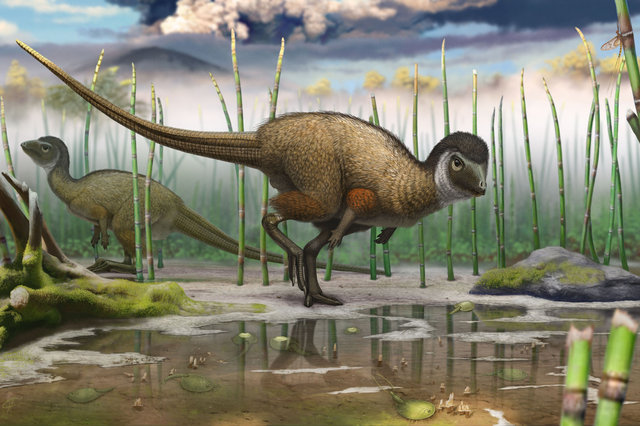by Russell Brandom

The way we think of dinosaurs may have to change
But a new find in Siberia has
paleontologists suspecting that look may be flat wrong. A team of
researchers led by Pascal Godefroit has found a new dinosaur with
ultra-thin feathers, joining other feathered species found in China and
North America. More importantly, the new find is the first
non-carnivorous dinosaur with feathers, which many in the field have
taken as evidence that feathers were far more widespread than previously
thought. If they're right, a big part of the way we think of dinosaurs
may have to change.
Godefriot's new creature is called the Kulindadromeus zabaikalicus
— a Jurassic creature about a meter and a half long, with large legs,
short arms, and a very long tail. Because of the unusually
well-preserved fossil, Godefroit could tell the Kulindadromeus had feathering on its torso and neck, but not its face, legs, or tail.
"Potentially, all dinosaurs could be covered with feathers."
Though feathered dinosaurs have
been found before — Chinese groups found feathers on dinosaurs back in
the 1990s — they have all been theropods, a class of upright dinosaurs
like the Tyrannosaurus rex, which let researchers explain the feathers as part of the creatures’ eventual evolution into birds. But the plant-eating Kulindadromeus
doesn't fit into that story. All the proto-bird species have been
carnivores, so these feathers must have grown up independently of that
evolutionary branch. That suggests that some dinosaurs, including many
of the better-known species, may have developed feathers independently.
"Probably more of them had feathers but those feathers were not
fossilized," Godefriot told The Verge. "Potentially, all dinosaurs could be covered with feathers."
An alternate illustration of the Kulindadromeus zabaikalicus.
"There are many, many questions left."
The theory has already found
support among others in the community. Darla Zelenitsky, who unearthed
the first feathered dinosaur in North America in 2012, says the growing
number of finds are pushing the paleontology community towards a tipping
point. "The popular scaly model of plant-eating dinosaurs may, in years
to come, be completely replaced by a feathered-scaly model," Zelenitsky
says. Since the Kulindadromeus is flightless, some have
speculated that the creature evolved feathers for warmth, which would
bring in a lot of other dinosaurs potential candidates.
The big issue is the absence of
evidence. Feathers aren't in our fossil record for most dinosaur
species, but it's hard to say if that's because the feathers were never
there or because they decomposed along the way. Paleontologists had been
assuming the creatures were featherless for evolutionary reasons — but
if theropods and the new Kulindadromeus developed feathers
independently, hundreds of other species could potentially have taken
the same route. "It's really just the starting point," Godefriot says,
"there are many many questions left."

No comments:
Post a Comment